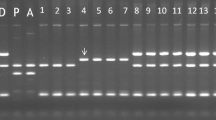Summary
By using restriction enzyme analysis of chloroplast DNA, a geographical cline from the Andean region to coastal Chile was found for the tetraploid potato (Solanum tuberosum). This supports the Andean origin of Chilean ssp. tuberosum. One of the relic cultivars of the early introduction of potato to Europe had ssp. andigena type chloroplast DNA. Its derivatives were largely lost in the mid-19th century due to the late blight epidemic and were replaced by ssp. tuberosum originally introduced from Chile. Therefore, the present common potato has the same type chloroplast DNA as Chilean ssp. tuberosum.
Similar content being viewed by others
References
Buckner B, Hyde BB (1985) Chloroplast DNA variation between the common cultivated potato (Solanum tuberosum ssp. tuberosum) and several South American relatives. Theor Appl Genet 71:527–531
Bukasov SM (1933) The potatoes of South America and their breeding possibilities. Bull Appl Bot Leningrad (Suppl) 58:1–192
Bukasov SM (1966) Die Kulturarten der Kartoffel und ihre wildwachsenden Vorfahren. Z Pflanzenzücht 55:139–164
Cubillos AG, Plaisted RL (1976) Heterosis for yield in hybrids between S. tuberosum ssp. tuberosum and tuberosum ssp. andigena. Am Potato J 53:143–150
Gatenby AA, Cocking EC (1978) Fraction 1 protein and the origin of the European potato. Plant Sci Lett 12:177–181
Glendinning DR (1969) The performance of progenies obtained by crossing Groups Andigena and Tuberosum of Solanum tuberosum. Eur Potato J 12:13–19
Grun P (1973) Cytoplasmic sterilities that separate the Group Tuberosum cultivated potato from its putative tetraploid ancestor. Evolution 27:633–643
Grun P, Ochoa C, Capage D (1977) Evolution of cytoplasmic factors in tetraploid cultivated potatoes (Solanaceae). Am J Bot 64:412–420
Hawkes JG (1956) Taxonomic studies on the tuber-bearing Solanums. 1. Solanum tuberosum and the tetraploid species complex. Proc Linn Soc London 166:97–144
Hawkes JG (1967) The history of the potato. J R Hortic Soc 92:201–262; 288–302
Hawkes JG (1972) Evolution of the cultivated potato Solanum tuberosum L. Symp Biol Hung 12:183–188
Hawkes JG (1978) Biosystematics of the potato. In: Harris PM (ed) The potato crop. Chapman and Hall, London, pp 15–69
Hoopes RW, Plaisted RL, Cubillos AG (1980) Yield and fertility of reciprocal-cross Tuberosum-Andigena hybrids. Am Potato J 57:275–284
Hosaka K (1986) Who is the mother of the potato? — restriction endonuclease analysis of chloroplast DNA of cultivated potatoes. Theor Appl Genet 72:606–618
Hosaka K, Hanneman RE Jr (1987) A rapid and simple method for determination of potato chloroplast DNA type. Am Potato J 64:345–353
Hosaka K, Hanneman RE Jr (1988) Origin of chloroplast DNA diversity in the Andean potatoes. Theor Appl Genet (in print)
Hosaka K, Ogihara Y, Matsubayashi M, Tsunewaki K (1984) Phylogenetic relationship between the tuberous Solanum species as revealed by restriction endonuclease analysis of chloroplast DNA. Jpn J Genet 59:349–369
Hosaka K, de Zoeten GA, Hanneman RE Jr (1988) Cultivated potato chloroplast DNA differs from the wild type by one deletion — Evidence and implications. Theor Appl Genet 75:741–745
Salaman RN (1926) Potato varieties. Cambridge University Press, London, 378 pp
Salaman RN (1937) The potato in its early home and its introduction into Europe. J R Hortic Soc 62:61–77; 112–123; 153–162; 253–266
Salaman RN (1946) The early European potato: its character and place of origin. J Linn Soc London Bot 53:1–27
Salaman RN (1949) The history and social influence of the potato. Cambridge University Press, London, 685 pp
Shepard JF, Bidney D, Barsby T, Kemble R (1983) Genetic transfer in plants through interspecific protoplast fusion. Science 219:683–688
Simmonds NW (1964) Studies of the tetraploid potatoes. 2. Factors in the evolution of the Tuberosum Group. J Linn Soc London Bot 59:43–56
Tarn TR, Tai GCC (1977) Heterosis and variation of yield components in F1 hybrids between Group Tuberosum and Group Andigena potatoes. Crop Sci 17:517–521
Ugent D, Dillehay T, Ramirez C (1987) Potato remains from a Late Pleistocene settlement in southcentral Chile. Econ Bot 41:17–27
Author information
Authors and Affiliations
Additional information
Communicated by K. Tsunewaki
Rights and permissions
About this article
Cite this article
Hosaka, K., Hanneman, R.E. The origin of the cultivated tetraploid potato based on chloroplast DNA. Theoret. Appl. Genetics 76, 172–176 (1988). https://doi.org/10.1007/BF00257842
Received:
Accepted:
Issue Date:
DOI: https://doi.org/10.1007/BF00257842




